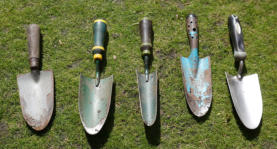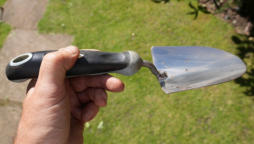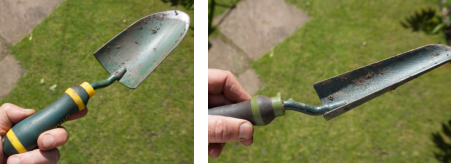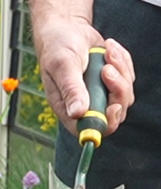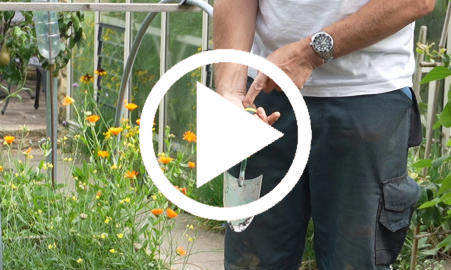

Email: graham@gardeningwithgraham.com
Terms and conditions
Follow on Instagram: gardening_with_graham_and_pam
© Gardeningwithgraham.com 2023


Trowels
A trowel is one of those tools that you can buy cheaply, for many this will is ideal, but cheap ones do have their problems. Generally cheaper trowels are weaker pressed steel, as with the trowel on the left and the blue trowel in the picture to the right. These are more likely to bend if you exert any kind of pressure on them. So will not last long if used for digging plants or weeds out of heavy clay soils. For this I would recommend a much stronger trowel like the other three. This picture is a selection of trowels available to me for use when planting both at home and at the allotment. These are not the only type of trowel available as anyone who watches gardeners world will know. Monty Don and Adam frost are regularly seen planting with a trowel that looks more like a tiny spade. I can’t say how good these are because I have never used one. Most manufacturers seem to have the opinion that you must put a hole in the handle to hang the trowel up (which is unnecessary because they can easily be hung upside down resting on two nails). This hole is a big problem because it causes blisters in the palms of your hand as seen to the left. This was after planting just thirty six leeks. When I was at collage one of the first things that they taught us about choosing tools was to avoid buying tools such as trowels and hoes with holes in the handles because they always cause a problem with your hands when used for prolonged periods. Unfortunately it is very hard to get a trowel without a hole in the handle. The only company’s that I can find that do produce a standard trowel without holes in are Bulldog and Spear and Jackson, but if you know of another manufacturer that does not put holes in the handles please let me know. Lets take a look at the trowels that I have. First off lets look at the two pressed steel trowels. The one on the left was actually a pretty good, strong trowel when I bought it about 35 years ago. The handle top has no hole and the steel was relatively strong though ane and rust has changed this the trowel has now started to bend where it is attached to the handle. This is the typical place where I would expect a problem from this type of trowel. The trowel on the right was bought when I needed a trowel urgently while on a job and I had a works experience student spend the week with me. I was already on the job when I got a call letting me know that she was coming so I had to buy the trowel locally. It has turned out to be a more sturdy trowel than expected but the handle is a big problem due to all the holes. It must be used while wearing gloves (which does not work for me). This trowel would have been perfect for me if it wasn’t for the hole in the handle. The blade is made from stainless steel so will not rust if you forget to clean it after use or if you leave it outside in the rain by mistake. The shape of the blade is great for planting bedding or vegetables and sharp enough to go into the ground without too much effort. When used for removing weeds or transplanting small plants there is no weakness in the shaft. I do expect this trowel to perhaps last my lifetime, at least for what I use it for. It is such a shame about the handle, not only does it have a hole, but the edges of the hole are raised making the rubbing effect much worse. These last two trowels, although not stainless steel both have a great blade. The right trowel is a long narrow trowel for bulb planting but also great for taking out dandelions. These were a set that Pam bought me several years ago, the handles do not have a hole in which is great, but unfortunately the yellow bands are nearly as bad. The yellow band is a different plastic to the rest of the handle and slightly proud, sticking up enough to make my hand sore after prolonged use. Again this would not be a problem if I wore gloves but this is not how I choose to do my gardening most of the time. Using a trowel The way you use a trowel is important. If you use it incorrectly you are more likely to suffer injuries to your wrist and get fatigued when planting lots of plants. The best way to grip your trowel is with the handle in the palm of your hand, your thumb running down along one side and your fingers curled tightly around the handle as seen in the picture to the left. When planting with the trowel you should keep your wrist and forearm in a straight line (keep the trowel blade and handle inline with your forearm) during the thrust into the soil. This is important to help prevent any injuries to your wrist. Planting is then achieved by thrusting the trowel into the soil and pulling the soil out to the side. When planting into firm soil such as clay, do not attempt to dig the hole in one single thrust but repeat the whole process multiple times turning the trowel around to the produce the intended hole. I have put together this small tutorial video to help you better understand how to use a trowel.When you purchase through links on our site, we may earn an affiliate commission. Learn more
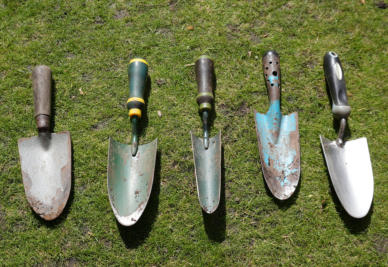
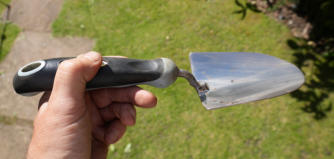
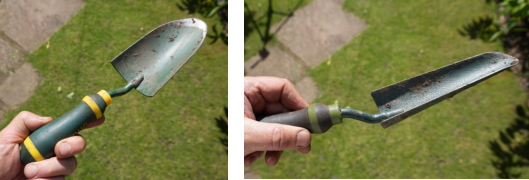
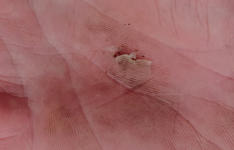

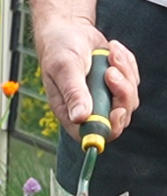
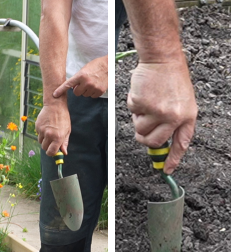
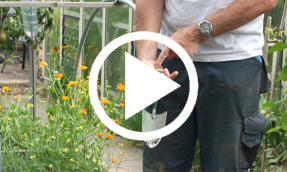


Email: graham@gardeningwithgraham.com
Terms and conditions
Follow on Instagram: gardening_with_graham_and_pam
© Graham Clark 2022

Trowels
A trowel is one of those tools that you can buy cheaply, for many this will is ideal, but cheap ones do have their problems. Generally cheaper trowels are weaker pressed steel, as with the trowel on the left and the blue trowel in the picture to the right. These are more likely to bend if you exert any kind of pressure on them. So will not last long if used for digging plants or weeds out of heavy clay soils. For this I would recommend a much stronger trowel like the other three. This picture is a selection of trowels available to me for use when planting both at home and at the allotment. These are not the only type of trowel available as anyone who watches gardeners world will know. Monty Don and Adam frost are regularly seen planting with a trowel that looks more like a tiny spade. I can’t say how good these are because I have never used one. Most manufacturers seem to have the opinion that you must put a hole in the handle to hang the trowel up (which is unnecessary because they can easily be hung upside down resting on two nails). This hole is a big problem because it causes blisters in the palms of your hand as seen to the left. This was after planting just thirty six leeks. When I was at collage one of the first things that they taught us about choosing tools was to avoid buying tools such as trowels and hoes with holes in the handles because they always cause a problem with your hands when used for prolonged periods. Unfortunately it is very hard to get a trowel without a hole in the handle. The only company’s that I can find that do produce a standard trowel without holes in are Bulldog and Spear and Jackson, but if you know of another manufacturer that does not put holes in the handles please let me know. Lets take a look at the trowels that I have. First off lets look at the two pressed steel trowels. The one on the left was actually a pretty good, strong trowel when I bought it about 35 years ago. The handle top has no hole and the steel was relatively strong though ane and rust has changed this the trowel has now started to bend where it is attached to the handle. This is the typical place where I would expect a problem from this type of trowel. The trowel on the right was bought when I needed a trowel urgently while on a job and I had a works experience student spend the week with me. I was already on the job when I got a call letting me know that she was coming so I had to buy the trowel locally. It has turned out to be a more sturdy trowel than expected but the handle is a big problem due to all the holes. It must be used while wearing gloves (which does not work for me). This trowel would have been perfect for me if it wasn’t for the hole in the handle. The blade is made from stainless steel so will not rust if you forget to clean it after use or if you leave it outside in the rain by mistake. The shape of the blade is great for planting bedding or vegetables and sharp enough to go into the ground without too much effort. When used for removing weeds or transplanting small plants there is no weakness in the shaft. I do expect this trowel to perhaps last my lifetime, at least for what I use it for. It is such a shame about the handle, not only does it have a hole, but the edges of the hole are raised making the rubbing effect much worse. These last two trowels, although not stainless steel both have a great blade. The right trowel is a long narrow trowel for bulb planting but also great for taking out dandelions. These were a set that Pam bought me several years ago, the handles do not have a hole in which is great, but unfortunately the yellow bands are nearly as bad. The yellow band is a different plastic to the rest of the handle and slightly proud, sticking up enough to make my hand sore after prolonged use. Again this would not be a problem if I wore gloves but this is not how I choose to do my gardening most of the time. Using a trowel The way you use a trowel is important. If you use it incorrectly you are more likely to suffer injuries to your wrist and get fatigued when planting lots of plants. The best way to grip your trowel is with the handle in the palm of your hand, your thumb running down along one side and your fingers curled tightly around the handle as seen in the picture to the left. When planting with the trowel you should keep your wrist and forearm in a straight line (keep the trowel blade and handle inline with your forearm) during the thrust into the soil. This is important to help prevent any injuries to your wrist. Planting is then achieved by thrusting the trowel into the soil and pulling the soil out to the side. When planting into firm soil such as clay, do not attempt to dig the hole in one single thrust but repeat the whole process multiple times turning the trowel around to the produce the intended hole. I have put together this small tutorial video to help you better understand how to use a trowel.
When you purchase through links on our site, we may earn an affiliate commission. Learn more
